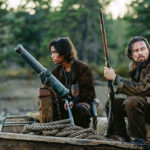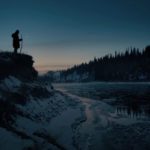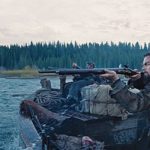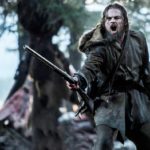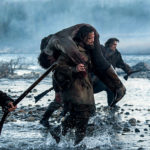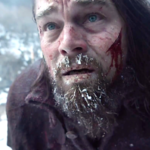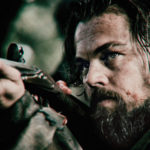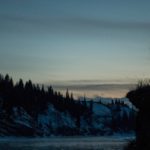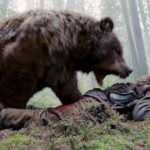I’ve got a new smart TV with home cinema sound system, all the better to admire movies in ultra-high definition 4k resolution (four times better than the now old hat 1080 high def.) I knew you’d be impressed! The effect is staggering, way better than I could have anticipated, but does need very high quality source to get the best.
My Blu-ray discs have never looked better, and stuff on Netflix designed for ultra-high looks so realistic you’d be convinced the characters are about to step off screen and into your living room. To show off the glorious capabilities of this equipment to my technophobe mother and technophile son during their visit, I needed a movie with staggering visuals, the sort you can wallow in for its beauty alone, quite apart from the drama and performances.
So it was that I paid a tenner for the Blu-ray of The Revenant, in spite of my well-known aversion to the talents of Mr DiCaprio. The fact that he finally, finally won a Best Actor Oscar for the role makes the film worth seeing out of curiosity alone. Alas, that took a little fiddling about, since the BR disc in question was not playing ball. Indeed, when you pressed ‘play’ from the menu, it crashed and all was darkness.
Not being put off so easily, I found an option for viewing the film in UHD format online, which gave me ample opportunity to check out the TV’s star credentials. Lo and behold, it worked, although you had to be careful not to press the wrong button and accidentally return to the Apps menu. That apart, we were able to view at the finest possible definition for home viewing, in the absence of a full-size cinema in my humble home.
First thing to note is that is partly based on Michael Punke‘s novel of the same name, which in turn was a fictionalised version “inspired by” the life and travels of frontiersman Hugh Glass on Andrew Henry‘s expedition to explore uncharted lands occupied by Arikara (aka Ree) and Pawnee native Americans (you know, the people who never existed if you believe the Republican party) and trap wildlife to trade their pelts, they being trappers for a living.
It is unquestionably true that Glass survived a mauling by a grizzly bear, but much of the remainder is fictional, including Glass’s Pawnee wife and son Hawk (Forrest Goodluck), whose death at the hands of another fictional character, John Fitzgerald (Tom Hardy.) Why fictionalise, you might wonder, when it turns out the real life story of Glass is more fantastic than the events portrayed on screen. See here if you don’t believe me!
But let’s start with DiCaprio. For most of his career I’ve viewed him as vastly overrated, deficient in technique, and routinely acted off the screen by craftsmen character actors. He has been improving in recent years though, notably in Django Unchained and Wolf of Wall Street but had a long way to travel to get in my top hundred favourite actors. Here too, since he is cast opposite the illustrious and ubiquitous Hardy, cast here as the principle villainous antagonist, an actor never known to put a foot wrong.
How does Leo get on? One thing worth saying is that at no point does he outperform Hardy, who was nominated for Best Supporting Actor but lost out to another Brit, Mark Rylance. No question that Leo holds his own in their scenes together, but won the Oscar for two reasons: it was “his turn”; and he does The Method to the final gruelling mile to demonstrate survival against the odds, of which more anon – but let it be said: Leo does the endurance thing as well as any actor before or since.
So what do I make of Alejandro González Iñárritu‘s (he of Gravity and Birdman fame) movie, one heaped with praise and a glittering array of gongs? It’s a very simple tale of revenge and survival told over 146 minutes with minimal dialogue. Visuals dominate the experience, which means either you need excellent home cinema gear (see above) or see it at your local multiplex.
The scenery looks beyond ravishing, and the film fully worthy of Emmanuel Lubezki‘s Oscar for best cinematography. The landscape is wild and unforgiving, and all the better for the fact that this has largely been achieved without the benefit of CGI – just man and nature and natural lighting.
I’m taking the one exception to the CGI rule to be where the grizzly gives Leo a good pounding, and darn near kills Glass. That he survives the attack is amazing, quite apart from this subsequent journey to revenge himself on Fitzgerald, who, dirty dog that he is, wanted to euthanise Glass for the good of the group, but kills who he can and leaves the floundering group with a young Jim Bridger (Will Poulter), and also survives against the odds.
To achieve the impact, shooting was divided between Canada and Patagonia, thanks to extended filming and warming temperatures. Unsurprisingly, the cast say it was the most demanding movie they ever completed, to the extent of risking hypothermia. Oh, how we suffer for our art! (see Wikipedia section on filming below.) I’m told that the vegetarian DiCaprio even ate a slab of raw bison liver for authenticity, and did indeed sleep in the carcass of a dead horse to keep warm.
Forget for a moment the accuracy of the narrative: it is probably more authentic than any movie has ever achieved in recreating the the atmosphere of the period and what life was truly like for the pioneers – which puts it on a par with Herzog‘s astonishing oeuvre, notably Aguirre, Wrath of God and Fitzcarraldo. Granted that it would be madness for DiCaprio to try to compete with the lunacy of Klaus Kinski, but The Revenant is certainly worthy of succeeding the spirit of these cinematic benchmarks.
That said, I find The Revenant admirable rather than enjoyable. I’ll watch it again, to be sure, but didn’t find myself hanging on to the every exploit of Glass and Fitzgerald so much as taking in the scenery and derring do. There is one honourable exception to that, which cunning surprise I won’t spoil – but it stands out a mile as the craftiest moment of the movie. See if you can spot it coming, because I didn’t. Truth be told, the film needed more plot to make it seem less of a snowbound and expensive spaghetti western, The Hateful Eight without the intrigue. That is, the human drama needed to offer greater intrigue. As it stands you could easily lose 40 minutes without harming the film at all.
That apart, there is more than a little inevitability to the proceedings: Glass survives, Fitzgerald doesn’t. C’est la vie – they could probably have found easier ways of living, but the adventure and the risk of death by nature, animals, drowning or gunshot didn’t put them off. These frontiersmen sure had a strong constitution!
Principal photography for The Revenant began in October 2014. A planned two-week break from filming in December was extended to six weeks which forced Tom Hardy to drop out of Suicide Squad. In February 2015, Iñárritu, who shot the film using natural lighting, stated that production would last “until the end of April or May”, as the crew is “shooting in such remote far-away locations that, by the time we arrive and have to return, we have already spent 40% of the day”. Brad Weston, president and CEO of New Regency Pictures, stated that principal photography had been challenging due to the ambitious nature of the film. Ultimately, principal photography wrapped in August 2015.
The film was shot in twelve locations in three countries: Canada, the United States, and Argentina. In Canada, filming took place in Calgary and Fortress Mountain in Alberta, and at Squamish and Mammoth Studios, Burnaby, in British Columbia.[31]While the initial plan was to film entirely in Canada, the weather was ultimately too warm, leading the filmmakers to locations at the tip of Argentina with snow on the ground, to shoot the film’s ending.
Crew members often complained about difficult shoots, with many quitting or being fired. Mary Parent was then brought in as a producer. Iñárritu stated that some of the crew members had left the film, explaining that “as a director, if I identify a violin that is out of tune, I have to take that from the orchestra.” On his experience filming, DiCaprio stated: “I can name 30 or 40 sequences that were some of the most difficult things I’ve ever had to do. Whether it’s going in and out of frozen rivers, or sleeping in animal carcasses, or what I ate on set. [I was] enduring freezing cold and possible hypothermia constantly.”
Iñárritu had stated that he originally wanted to shoot the film chronologically, a process that would have added $7 million to the film’s production budget. Iñárritu later confirmed that the film was shot in sequence, despite Hardy’s statement that the film could not be shot chronologically, due to weather conditions.
In July 2015, it was reported that the film’s budget had ballooned from the original $60 million to $95 million, and by the time production wrapped it had reached $135 million.




